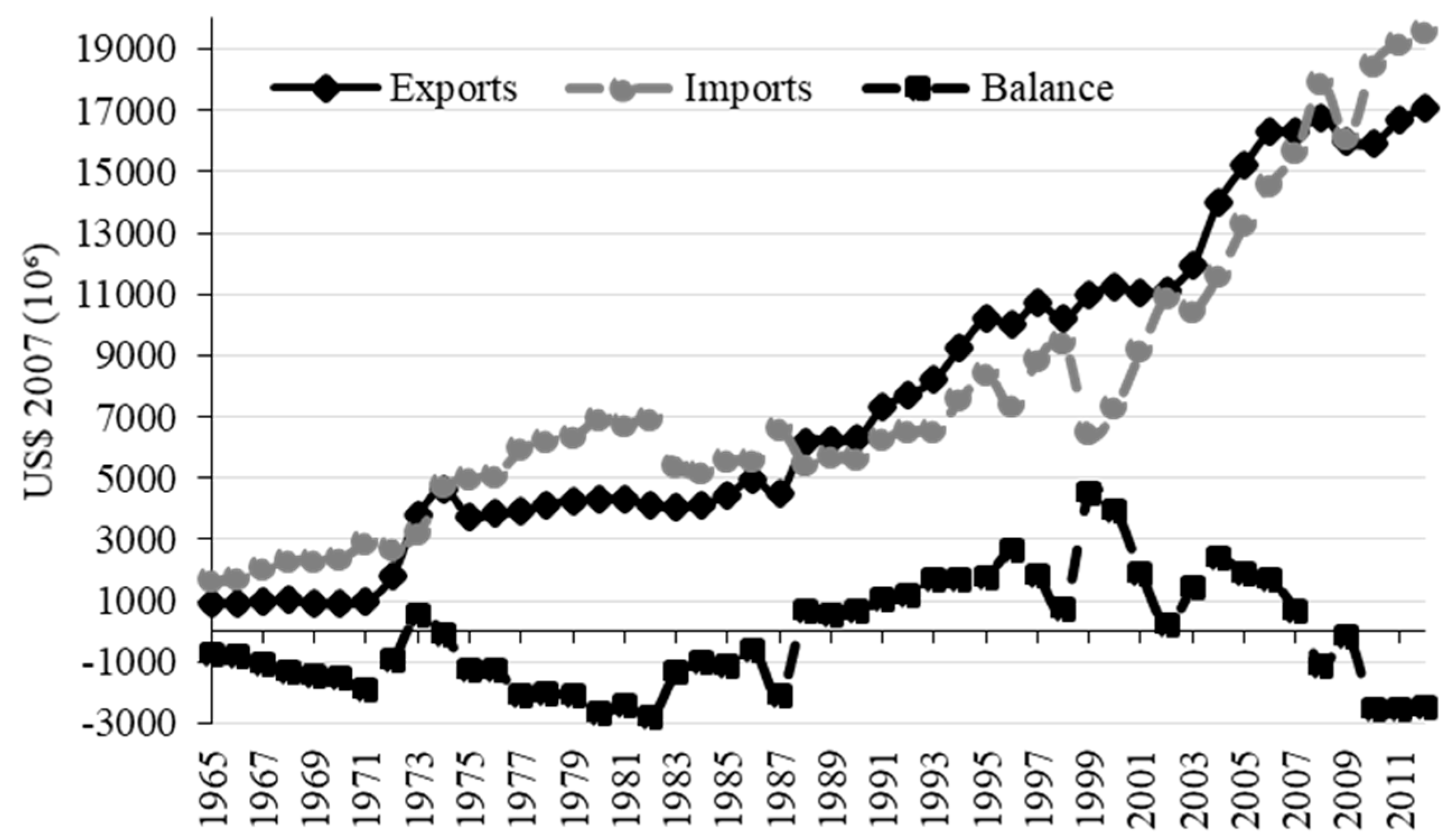The Concept of Caloric Unequal Exchange and Its Relevance for Food System Analysis: The Ecuador Case Study
Abstract
:1. Introduction
2. Materials and Methods
3. Results
3.1. Ecuadorean International Trade Insertion
3.2. Caloric Unequal Exchange and the Relationship between Trade Patterns and Consumption
3.2.1. Existence of Caloric Unequal Exchange
3.2.2. Concentration of Consumption
3.2.3. Loss of Self-Sufficiency
4. Discussion
5. Conclusions
Supplementary Materials
Acknowledgments
Author Contributions
Conflicts of Interest
References
- Institute of Medicine (US) Committee on Dietary Guidelines Implementation. Improving America’s Diet and Health; Thomas, P.R., Ed.; National Academy Press: Washington, DC, USA, 1991; ISBN 0-309-57442-0. [Google Scholar]
- Coyle, W.; Gehlhar, M.; Hertel, T.W.; Wang, Z.; Yu, W. Understanding the Determinants of Structural Change in World Food Markets. Am. J. Agric. Econ. 1998, 80, 1051. [Google Scholar] [CrossRef]
- Falconí, F.; Ramos-Martin, J.; Cango, P. Caloric unequal exchange in Latin America and the Caribbean. Ecol. Econ. 2017, 134, 140–149. [Google Scholar] [CrossRef]
- Grote, U.; Craswell, E.; Vlek, P. Nutrient flows in international trade: Ecology and policy issues. Environ. Sci. Policy 2005, 8, 439–451. [Google Scholar] [CrossRef]
- Prebish, R. Commercial policy in the underdeveloped countries. Am. Econ. Rev. 1959, 49, 251–273. [Google Scholar]
- Prebish, R. The Economic Development of Latin America and Its Principal Problems; Economic Commission for Latin America (ECLA): New York, NY, USA, 1950. [Google Scholar]
- Singer, H.W. The distribution of gains between investing and borrowing countries. Am. Econ. Rev. 1950, 40, 473–485. [Google Scholar]
- Furtado, C. Obstacles to Development in Latin America; Anchor Books: Garden City, NY, USA, 1970. [Google Scholar]
- Furtado, C. Development and Underdevelopment; University of California Press: Berkeley, CA, USA, 1964; ISBN 978-0520004436. [Google Scholar]
- Emmanuel, A. Unequal Exchange: A Study of the Imperialism of Trade; New Left Books: New York, NY, USA, 1972; ISBN 978-0902308831. [Google Scholar]
- Amin, S. Unequal Development: An Essay on the Social Formations of Peripheral Capitalism; Monthly Review Press: New York, NY, USA, 1976; ISBN 978-0853454335. [Google Scholar]
- Bunker, S.G. Modes of extraction, unequal exchange, and the progressive underdevelopment of an extreme periphery: The Brazilian Amazon, 1600–1980. Am. J. Sociol. 1984, 89, 1017–1064. [Google Scholar] [CrossRef]
- Bunker, S.G. Underdeveloping the Amazon: Extraction, Unequal Exchange and the Failure of the Modern State; University of Chicago Press: Chicago, IL, USA, 1985; ISBN 9780226080321. [Google Scholar]
- Bunker, S.G. The poverty of resource extraction. In Rethinking Environmental History: World-System History and Global Environmental Change; Hornborg, A., McNeill, J.R., Martinez-Alier, J., Eds.; AltaMira Press: Lanham, MD, USA, 2007; pp. 239–258. [Google Scholar]
- Dorninger, C.; Hornborg, A. Can EEMRIO analyses establish the occurrence of ecologically unequal exchange? Ecol. Econ. 2015, 119, 414–418. [Google Scholar] [CrossRef]
- Hornborg, A. Towards an ecological theory of unequal exchange: Articulating world system theory and ecological economics. Ecol. Econ. 1998, 25, 127–136. [Google Scholar] [CrossRef]
- Hornborg, A. Zero-sum world: Challenges in conceptualizing environmental load displacement and ecologically unequal exchange in the world-system. Int. J. Comp. Sociol. 2009, 50, 237–262. [Google Scholar] [CrossRef]
- Hornborg, A. Ecological economics, marxism, and technological progress: Some explorations of the conceptual foundations of theories of ecologically unequal exchange. Ecol. Econ. 2014, 105, 11–18. [Google Scholar] [CrossRef]
- Jorgenson, A.K.; Rice, J. Uneven ecological exchange and consumption-based environmental impacts: A cross-national investigation. In Rethinking Environmental History: World-System History and Global Environmental Change; Hornborg, A., McNeill, J.R., Martinez-Alier, J., Eds.; AltaMira Press: Lanham, MD, USA, 2007; pp. 273–288. [Google Scholar]
- Muradian, R.; Giljum, S. Physical Trade Flows of Pollution-Intensive Products: Historical Trends in Europe and the World. In Rethinking Environmental History: World-System History and Global Environmental Change; Hornborg, A., McNeill, J.R., Martinez-Alier, J., Eds.; AltaMira Press: Lanham, MD, USA, 2007; pp. 307–325. [Google Scholar]
- Røpke, I. Ecological Unequal Exchange. J. Hum. Ecol. 2001, 10, 35–40. [Google Scholar]
- Jorgenson, A. Environment, development, and ecologically unequal exchange. Sustainability 2016, 8, 227. [Google Scholar] [CrossRef]
- Fitzgerald, J.; Auerbach, D. The political economy of the water footprint: A cross-national analysis of ecologically unequal exchange. Sustainability 2016, 8, 1263. [Google Scholar] [CrossRef]
- Muradian, R.; Martinez-Alier, J. Trade and the environment: From a “Southern” perspective. Ecol. Econ. 2001, 36, 281–297. [Google Scholar] [CrossRef]
- Machado, G.; Schaeffer, R.; Worrell, E. Energy and carbon embodied in the international trade of Brazil: An input–output approach. Ecol. Econ. 2001, 39, 409–424. [Google Scholar] [CrossRef]
- Muradian, R.; O’Connor, M.; Martinez-Alier, J. Embodied pollution in trade: Estimating the “environmental load displacement” of industrialised countries. Ecol. Econ. 2002, 41, 51–67. [Google Scholar] [CrossRef]
- Giljum, S. Trade, materials flows, and economic development in the South: The example of Chile. J. Ind. Ecol. 2004, 8, 241–261. [Google Scholar] [CrossRef]
- Pérez-Rincón, M.A. Comercio exterior y flujos hídricos en la agricultura colombiana: Análisis para el periodo 1961–2004. Rev. Iberoam. Econ. Ecol. 2006, 4, 3–16. [Google Scholar]
- Jorgenson, A.K. The sociology of ecologically unequal exchange and carbon dioxide emissions, 1960–2005. Soc. Sci. Res. 2012, 41, 242–252. [Google Scholar] [CrossRef] [PubMed]
- Jorgenson, A.K.; Dick, C.; Austin, K. The vertical flow of primary sector exports and deforestation in less-developed countries: A test of ecologically unequal exchange theory. Soc. Nat. Resour. 2010, 23, 888–897. [Google Scholar] [CrossRef]
- Jorgenson, A.K. The sociology of unequal exchange in ecological context: A panel study of lower-income countries, 1975–2000. Sociol. Forum 2009, 24, 22–46. [Google Scholar] [CrossRef]
- Eisenmenger, N.; Ramos-Martin, J.; Scheindl, H. Análisis del metabolismo energético y de materiales de Brasil, Chile y Venezuela. Rev. Iberoam. Econ. Ecol. 2007, 6, 17–39. [Google Scholar]
- Falconí, F.; Vallejo, M.C. Transiciones Socioecológicas en la Región Andina. Rev. Iberoam. Econ. Ecol. 2012, 18, 53–71. [Google Scholar]
- Hornborg, A.; Jorgenson, A.K. (Eds.) International Trade and Environmental Justice: Toward a Global Political Ecology; Nova Science Publishers, Inc.: Hauppauge, NY, USA, 2010; ISBN 978-1608764266. [Google Scholar]
- Pérez-Rincón, M.A. Colombian international trade from a physical perspective: Towards an ecological “Prebisch thesis”. Ecol. Econ. 2006, 59, 519–529. [Google Scholar] [CrossRef]
- Samaniego, P.; Vallejo, M.C.; Martínez-Alier, J. Déficit Comercial y Déficit Físico en Sudamérica; Documento de Trabajo, Proyectos CSO2010-21979 e ENGOV; Institut de Ciència i Tecnologia Ambientals (ICTA), Universidad Autónoma de Barcelona, FLACSO Sede Ecuador: Quito, Ecuador, 2014. [Google Scholar]
- Vallejo, M.C. Biophysical structure of the Ecuadorian economy, foreign trade, and policy implications. Ecol. Econ. 2010, 70, 159–169. [Google Scholar] [CrossRef]
- Pengue, W.A. Transgenic crops in Argentina: The ecological and social debt. Bull. Sci. Technol. Soc. 2005, 25, 314–322. [Google Scholar] [CrossRef]
- Pérez-Rincón, M.A. Comercio Internacional y Medio Ambiente en Colombia. Mirada Desde la Economía Ecológica; Universidad del Valle: Cali, Colombia, 2007; ISBN 9789584412171. [Google Scholar]
- Kennedy, G.; Nantel, G.; Shetty, P. Globalization of food systems in developing countries: A synthesis of country case studies. In Globalization of Food Systems in Developing Countries: Impact on Food Security and Nutrition; Food and Agriculture Organization of the United Nations: Rome, Italy, 2004; p. 97. [Google Scholar]
- Sherwood, S.; Arce, A.; Berti, P.; Borja, R.; Oyarzun, P.; Bekkering, E. Tackling the new materialities: Modern food and counter-movements in Ecuador. Food Policy 2013, 41, 1–10. [Google Scholar] [CrossRef]
- Thow, A.M.; Hawkes, C. The implications of trade liberalization for diet and health: A case study from Central America. Glob. Health 2009, 5, 5. [Google Scholar] [CrossRef] [PubMed]
- Thow, A.M.; Swinburn, B.; Colagiuri, S.; Diligolevu, M.; Quested, C.; Vivili, P.; Leeder, S. Trade and food policy: Case studies from three Pacific Island countries. Food Policy 2010, 35, 556–564. [Google Scholar] [CrossRef]
- Aldaya, M.M.; Allan, J.A.; Hoekstra, A.Y. Strategic importance of green water in international crop trade. Ecol. Econ. 2010, 69, 887–894. [Google Scholar] [CrossRef]
- Duarte, R.; Pinilla, V.; Serrano, A. The effect of globalisation on water consumption: A case study of the Spanish virtual water trade, 1849–1935. Ecol. Econ. 2014, 100, 96–105. [Google Scholar] [CrossRef]
- Hoekstra, A.Y.; Hung, P.Q. Globalisation of water resources: International virtual water flows in relation to crop trade. Glob. Environ. Chang. 2005, 15, 45–56. [Google Scholar] [CrossRef]
- Kastner, T.; Schaffartzik, A.; Eisenmenger, N.; Erb, K.H.; Haberl, H.; Krausmann, F. Cropland area embodied in international trade: Contradictory results from different approaches. Ecol. Econ. 2014, 104, 140–144. [Google Scholar] [CrossRef]
- Iannotti, L.; Robles, M. Negative impact on calorie intake associated with the 2006–08 food price crisis in Latin America. Food Nutr. Bull. 2011, 32, 112–123. [Google Scholar] [CrossRef] [PubMed]
- Falconi, F.; Oleas-Montalvo, J. Citizens revolution and international integration: Obstacles and opportunities in world trade. Lat. Am. Perspect. 2016, 43, 124–142. [Google Scholar] [CrossRef]
- Food and Agriculture Organization of the United Nations. FAOSTAT Database; FAO: Rome, Italy, 2016. [Google Scholar]
- Food and Agriculture Organization of the United Nations. Food Balance Sheets, A Handbook; FAO: Rome, Italy, 2001. [Google Scholar]
- Banco Central del Ecuador. Cuentas Nacionales Número 24; BCE: Quito, Ecuador, 2016. [Google Scholar]
- Banco Central del Ecuador. Cuentas Nacionales Número 25; BCE: Quito, Ecuador, 2016. [Google Scholar]
- Arizpe, N.; Giampietro, M.; Ramos-Martin, J. Food security and fossil energy dependence: An international comparison of the use of fossil energy in agriculture (1991–2003). CRC. Crit. Rev. Plant Sci. 2011, 30, 45–63. [Google Scholar] [CrossRef]
- Arizpe, N.; Ramos-Martín, J.; Giampietro, M. An assessment of the metabolic profile implied by agricultural change in two rural communities in the North of Argentina. Environ. Dev. Sustain. 2014, 16, 903–924. [Google Scholar] [CrossRef]

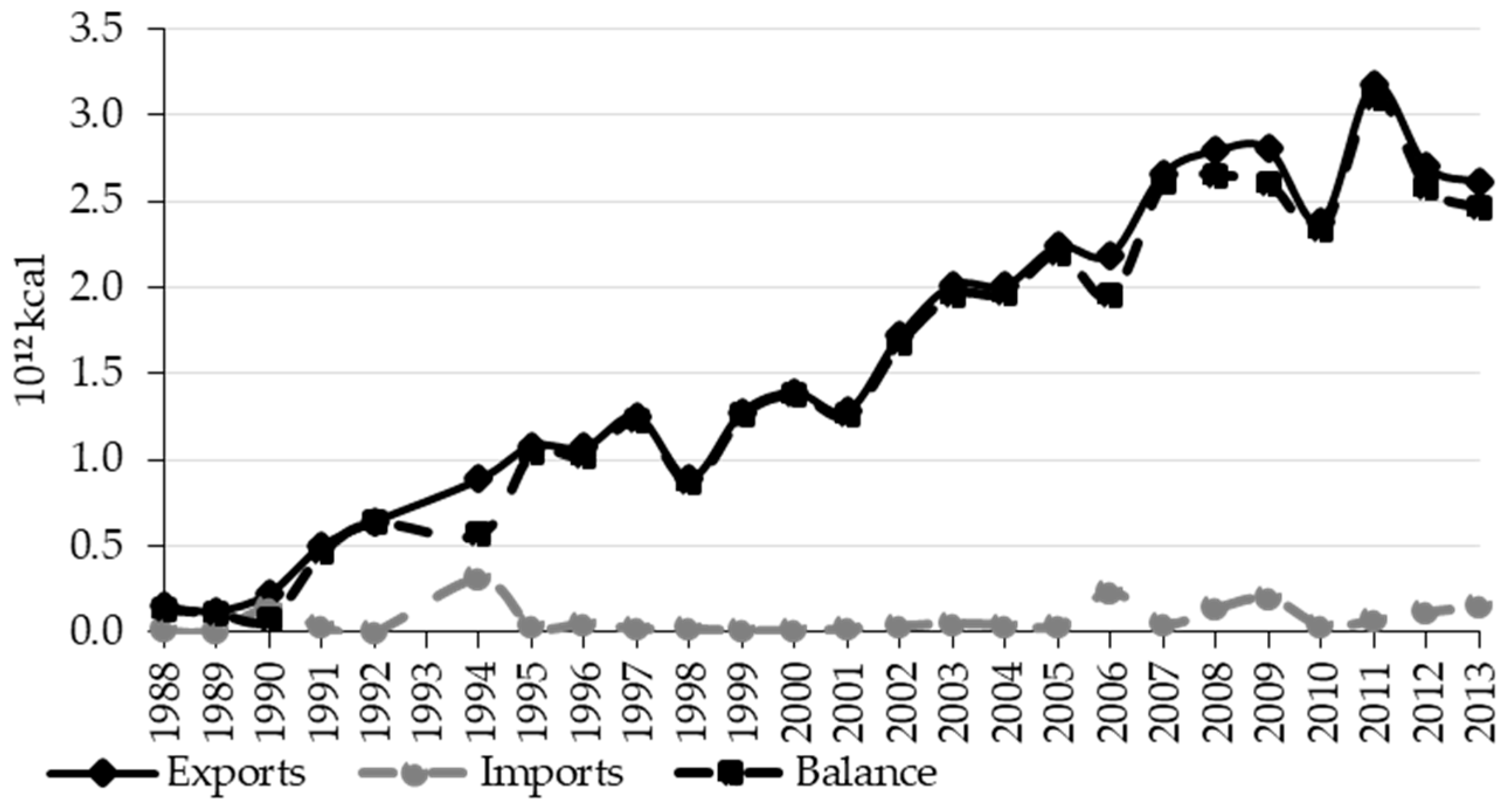
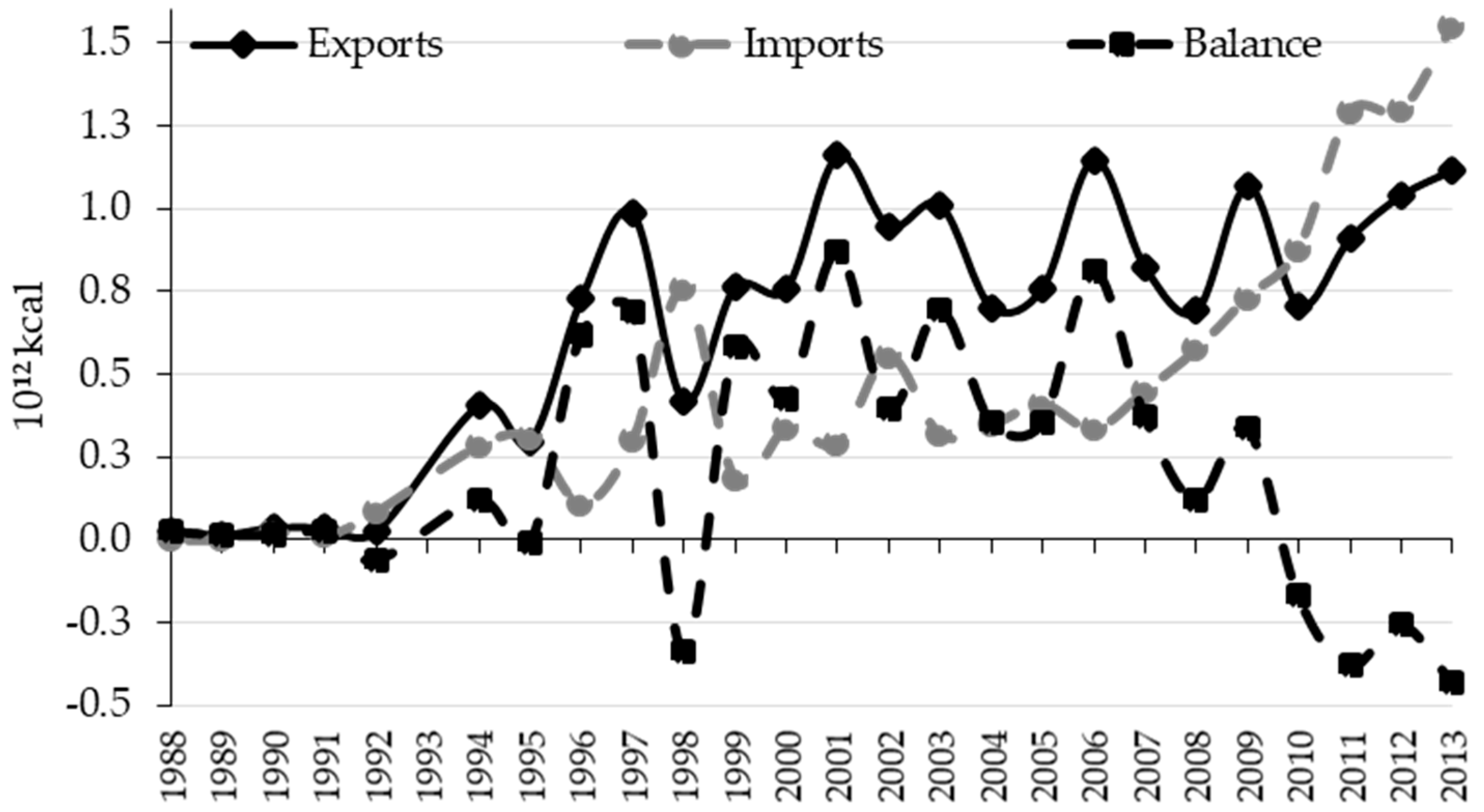
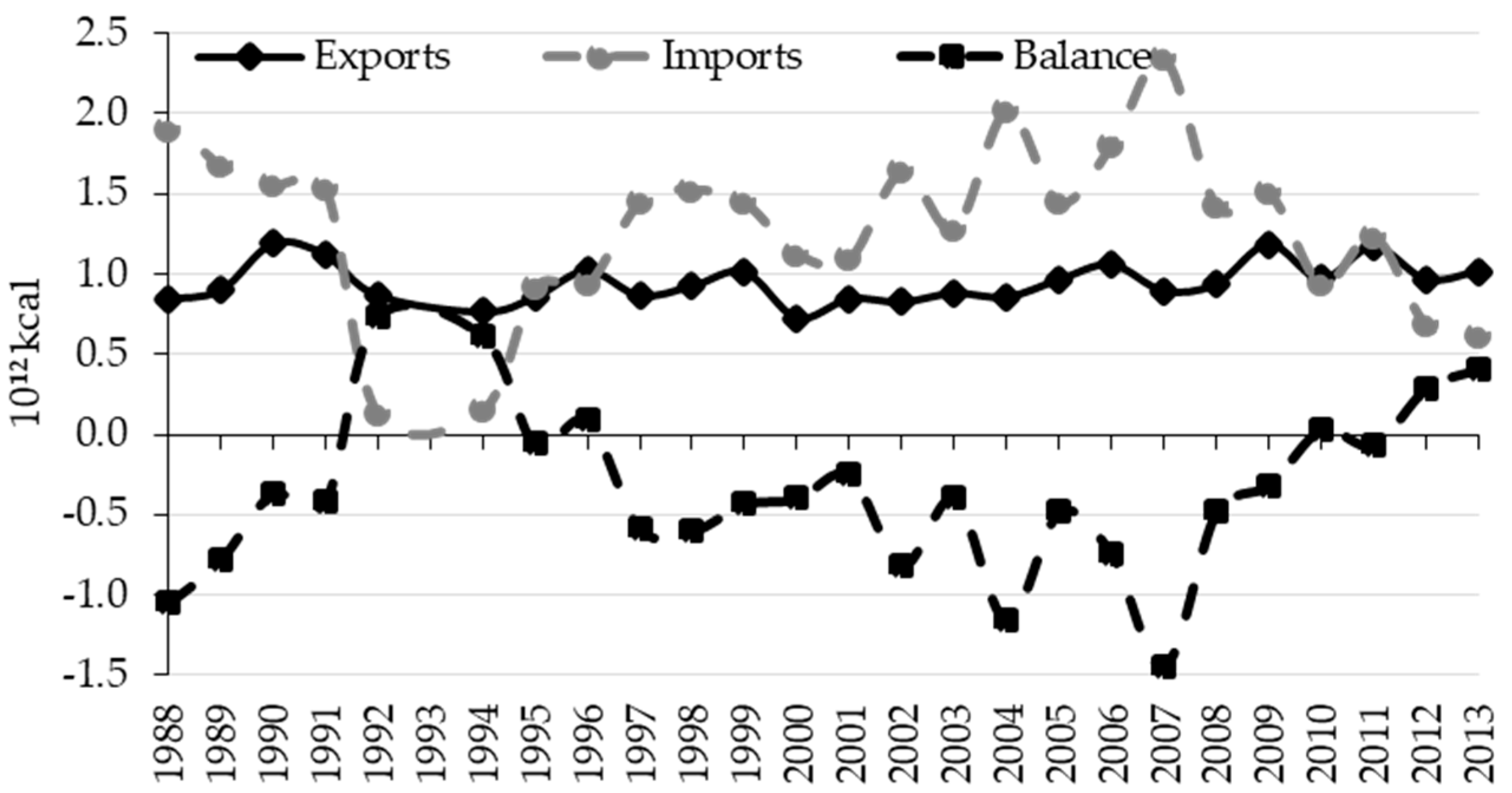
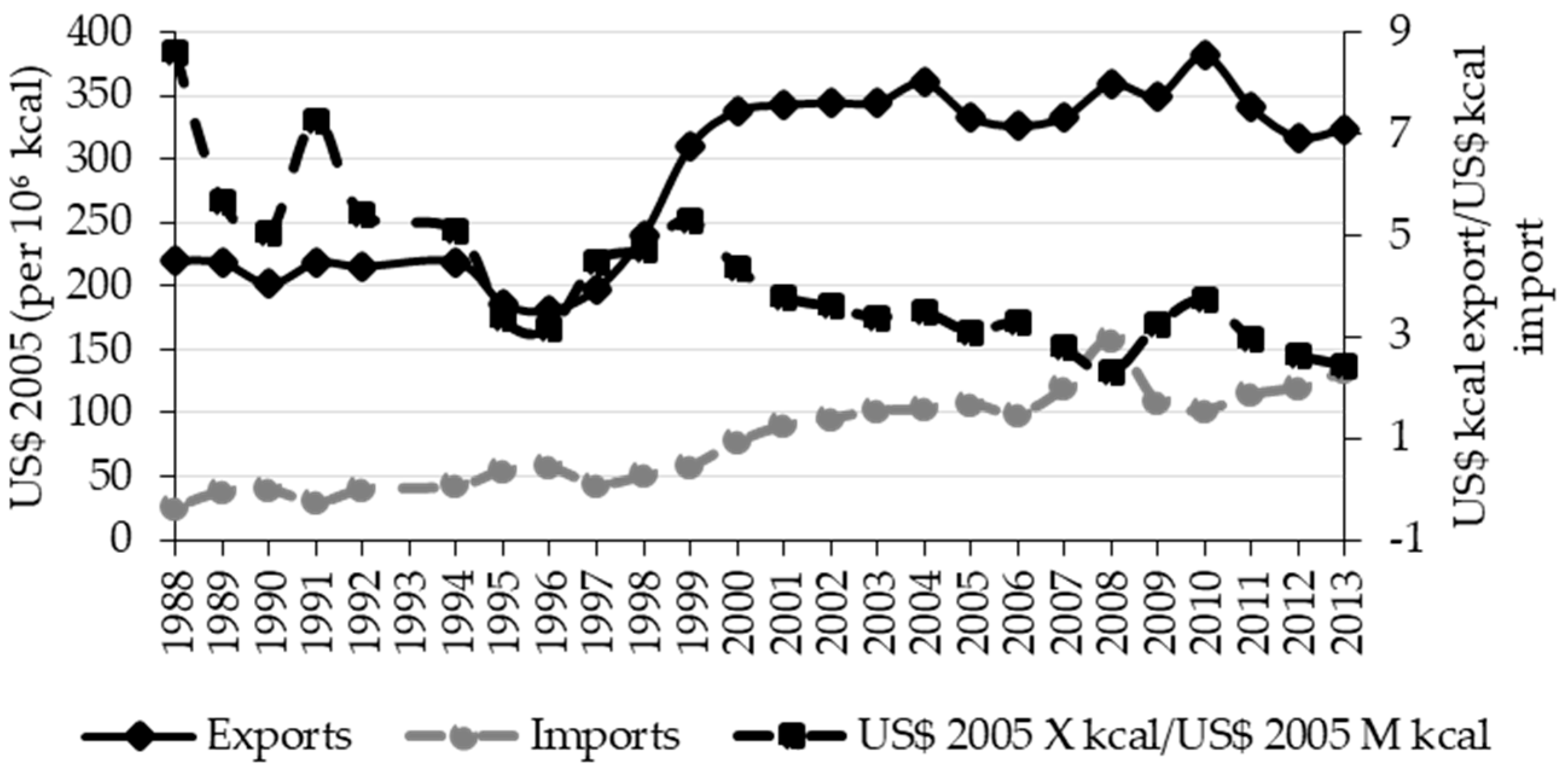


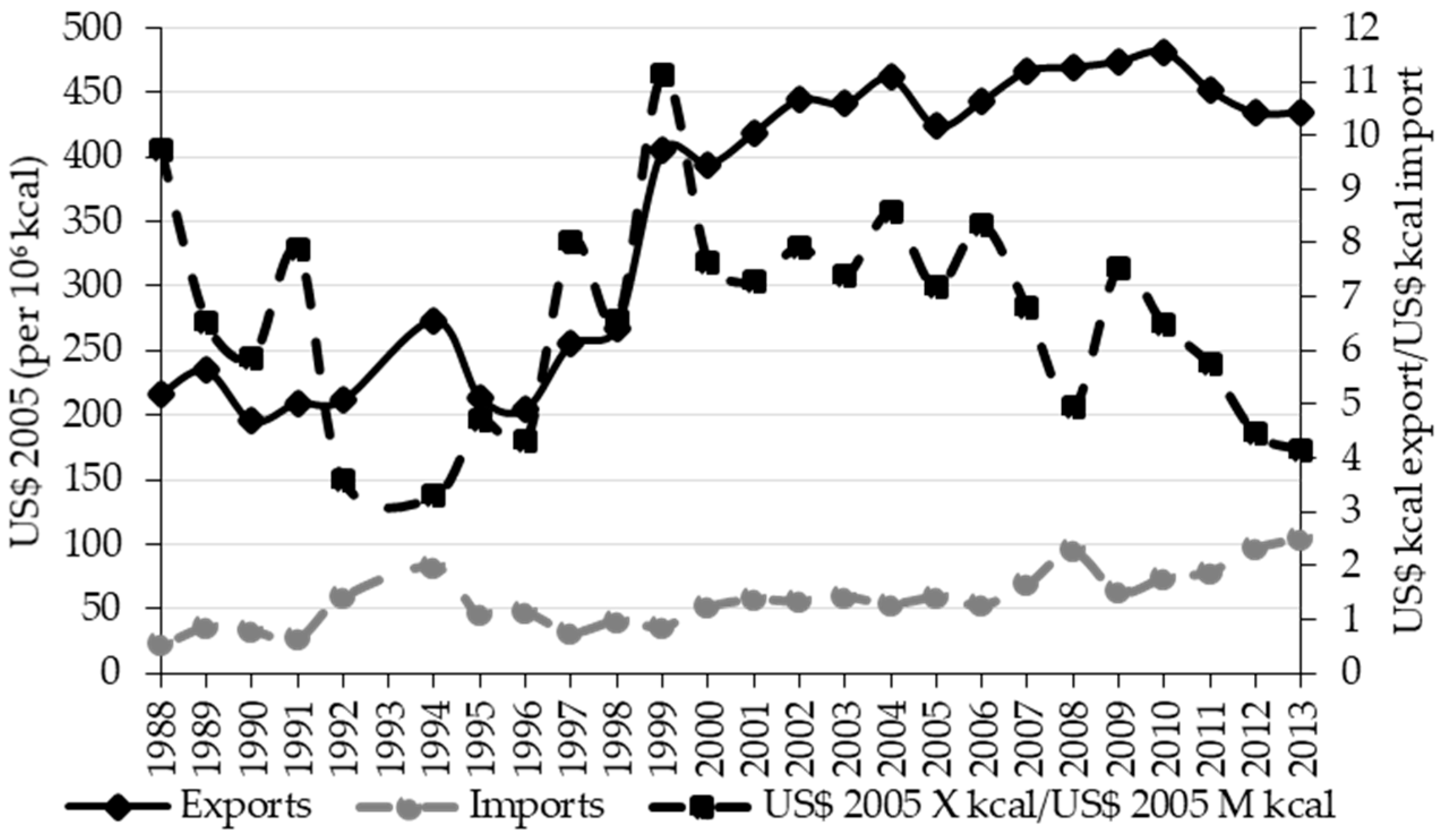
| Year | Exports (10³ Tn) | Imports (10³ Tn) | Exports (10⁶ US$ 2005) * | Imports (10⁶ US$ 2005) * | Exports (10¹² kcal) | Imports (10¹² kcal) |
|---|---|---|---|---|---|---|
| 1988 | 1526.5 | 637.5 | 282.3 | 57.7 | 1.3 | 2.2 |
| 1994 | 3492.5 | 547.1 | 610.9 | 81.6 | 2.8 | 1.9 |
| 2000 | 4610.5 | 808.0 | 1259.0 | 237.2 | 3.7 | 3.1 |
| 2005 | 5638.4 | 1367.4 | 1722.3 | 510.4 | 5.2 | 4.7 |
| 2009 | 6649.8 | 1504.5 | 2253.7 | 550.5 | 6.4 | 5.1 |
| 2013 | 6508.2 | 1358.4 | 2219.6 | 629.5 | 6.8 | 4.7 |
| Δ 1988–2013 | 4.3 | 2.1 | 7.9 | 10.9 | 5.3 | 2.1 |
| Product Group | 10¹² kcal/Year | % kcal by Products Group | Consumption kcal/Person/Day | |||||||||||||||
|---|---|---|---|---|---|---|---|---|---|---|---|---|---|---|---|---|---|---|
| 1961 | 1971 | 1981 | 1991 | 2001 | 2011 | 1961 | 1971 | 1981 | 1991 | 2001 | 2011 | 1961 | 1971 | 1981 | 1991 | 2001 | 2011 | |
| Cereals | 1.0 | 1.4 | 1.9 | 2.8 | 3.7 | 4.4 | 35.1 | 33.8 | 33.4 | 41.6 | 46.8 | 45.2 | 588.3 | 601.8 | 642.3 | 742 | 791.3 | 788.3 |
| Fruits | 0.6 | 0.7 | 1.0 | 0.8 | 1.2 | 1.3 | 20.0 | 18.0 | 18.2 | 12.4 | 14.8 | 13.3 | 336.0 | 320.2 | 350.9 | 221.9 | 251.1 | 232 |
| Sugar & Sweeteners | 0.4 | 0.8 | 1.2 | 1.0 | 0.8 | 1.0 | 15.2 | 18.8 | 20.3 | 15.1 | 10.5 | 10.6 | 254.5 | 335.0 | 390.6 | 269 | 178.3 | 185.2 |
| Starchy Roots | 0.3 | 0.5 | 0.3 | 0.3 | 0.3 | 0.2 | 10.0 | 11.7 | 5.7 | 3.9 | 3.8 | 2.6 | 167.1 | 209.0 | 109 | 68.98 | 64.9 | 44.88 |
| Vegetable Oils | 0.2 | 0.4 | 0.9 | 1.4 | 1.5 | 2.2 | 8.4 | 9.0 | 15.3 | 21.3 | 19.3 | 22.3 | 140.8 | 159.9 | 294.3 | 381 | 326.1 | 389.8 |
| Pulses | 0.2 | 0.2 | 0.1 | 0.1 | 0.1 | 0.1 | 6.1 | 4.6 | 2.4 | 1.8 | 1.7 | 1.4 | 102.6 | 82.0 | 46.39 | 32.6 | 28.71 | 24.23 |
| Vegetables | 0.1 | 0.1 | 0.1 | 0.1 | 0.1 | 0.1 | 2.3 | 1.7 | 1.1 | 1.1 | 0.9 | 1.2 | 39.0 | 30.0 | 21.04 | 20.01 | 16.03 | 20.99 |
| Oil crops | 0.0 | 0.0 | 0.1 | 0.0 | 0.0 | 0.1 | 1.7 | 1.2 | 0.9 | 0.4 | 0.4 | 0.8 | 28.3 | 21.7 | 17.86 | 7.462 | 6.889 | 14.45 |
| Alcoholic Beverages | 0.0 | 0.0 | 0.1 | 0.1 | 0.1 | 0.2 | 1.0 | 1.2 | 2.3 | 1.9 | 1.2 | 1.9 | 17.0 | 21.4 | 43.89 | 33.74 | 20.24 | 33.82 |
| Other * | 0.0 | 0.0 | 0.0 | 0.0 | 0.0 | 0.1 | 0.2 | 0.1 | 0.4 | 0.4 | 0.4 | 0.7 | 2.8 | 1.9 | 7.009 | 7.721 | 7.33 | 11.39 |
| Product Group | 1988 | 1994 | 2000 | 2005 | 2009 | 2013 | ||||||
|---|---|---|---|---|---|---|---|---|---|---|---|---|
| % X | % M | % X | % M | % X | % M | % X | % M | % X | % M | % X | % M | |
| Fruits—Excluding Wine | 62.5 | 0.0 | 67.7 | 0.7 | 67.9 | 0.6 | 58.2 | 0.9 | 55.3 | 1.1 | 50.7 | 1.7 |
| Stimulants | 26.1 | 0.0 | 13.0 | 0.4 | 8.0 | 0.2 | 7.7 | 0.6 | 9.2 | 0.4 | 12.2 | 0.7 |
| Sugar & Sweeteners | 6.3 | 8.4 | 2.4 | 15.7 | 3.2 | 3.2 | 4.8 | 4.7 | 1.3 | 3.1 | 0.5 | 3.1 |
| Vegetable Oils | 3.4 | 6.7 | 6.0 | 14.0 | 7.2 | 22.8 | 21.6 | 17.6 | 30.5 | 22.7 | 31.7 | 28.6 |
| Cereals—Excluding Beer | 1.6 | 84.2 | 10.0 | 63.8 | 9.4 | 69.3 | 4.6 | 71.5 | 1.9 | 68.4 | 2.6 | 61.5 |
| Vegetables | 0.0 | 0.0 | 0.1 | 0.1 | 0.4 | 0.3 | 0.5 | 0.4 | 0.4 | 0.9 | 0.6 | 0.8 |
| Alcoholic Beverages | 0.0 | 0.6 | 0.1 | 1.8 | 0.0 | 0.3 | 0.1 | 0.8 | 0.0 | 0.6 | 0.0 | 0.3 |
| Pulses | 0.0 | 0.0 | 0.1 | 2.2 | 0.6 | 2.9 | 1.1 | 2.7 | 0.3 | 1.8 | 0.4 | 2.0 |
| Spices | 0.0 | 0.0 | 0.0 | 0.2 | 0.0 | 0.1 | 0.0 | 0.1 | 0.0 | 0.1 | 0.0 | 0.2 |
| Starchy Roots | 0.0 | 0.0 | 0.1 | 0.0 | 0.7 | 0.0 | 0.8 | 0.1 | 0.5 | 0.2 | 0.2 | 0.2 |
| Other * | 0.0 | 0.0 | 0.4 | 1.2 | 2.6 | 0.3 | 0.8 | 0.5 | 0.6 | 0.6 | 1.0 | 1.0 |
| Number of Product | Product | % Cumulated 1961 | % Cumulated 2011 | Product |
|---|---|---|---|---|
| 1 | Rice (Milled Equivalent) | 12.0 | 24.0 | Rice (Milled Equivalent) |
| 2 | Sugar (Raw Equivalent) | 23.9 | 41.4 | Wheat and products |
| 3 | Maize and products | 34.0 | 53.9 | Palm Oil |
| 4 | Bananas | 43.4 | 63.9 | Sugar (Raw Equivalent) |
| 5 | Wheat and products | 52.7 | 71.1 | Soybean Oil |
| 6 | Plantains | 59.3 | 78.3 | Bananas |
| 7 | Potatoes and products | 64.8 | 82.1 | Plantains |
| 8 | Palm Oil | 70.1 | 84.7 | Maize and products |
| 9 | Cassava and products | 73.8 | 86.8 | Potatoes and products |
| 10 | Sugar non-centrifugal | 77.1 | 88.4 | Fruits, Other |
© 2017 by the authors. Licensee MDPI, Basel, Switzerland. This article is an open access article distributed under the terms and conditions of the Creative Commons Attribution (CC BY) license (http://creativecommons.org/licenses/by/4.0/).
Share and Cite
Ramos-Martín, J.; Falconí, F.; Cango, P. The Concept of Caloric Unequal Exchange and Its Relevance for Food System Analysis: The Ecuador Case Study. Sustainability 2017, 9, 2068. https://doi.org/10.3390/su9112068
Ramos-Martín J, Falconí F, Cango P. The Concept of Caloric Unequal Exchange and Its Relevance for Food System Analysis: The Ecuador Case Study. Sustainability. 2017; 9(11):2068. https://doi.org/10.3390/su9112068
Chicago/Turabian StyleRamos-Martín, Jesús, Fander Falconí, and Pedro Cango. 2017. "The Concept of Caloric Unequal Exchange and Its Relevance for Food System Analysis: The Ecuador Case Study" Sustainability 9, no. 11: 2068. https://doi.org/10.3390/su9112068
APA StyleRamos-Martín, J., Falconí, F., & Cango, P. (2017). The Concept of Caloric Unequal Exchange and Its Relevance for Food System Analysis: The Ecuador Case Study. Sustainability, 9(11), 2068. https://doi.org/10.3390/su9112068




